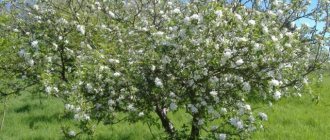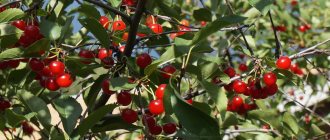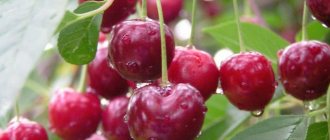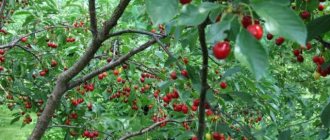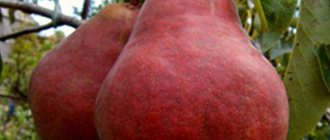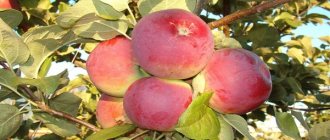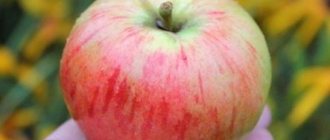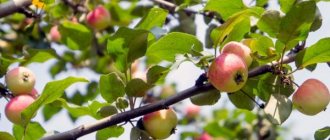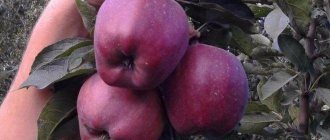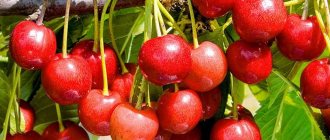History of selection and region of breeding
Novella is a high-yielding, winter-hardy cherry variety, medium ripening, universal purpose.
Universal varieties also include Vyanok, Kharitonovskaya and Chernaya Krupnaya.
It was obtained in Orel on the basis of the All-Russian Scientific Research Institute for Breeding Fruit Crops through the hybridization of the Rossoshanskaya and Vozrozhdenie (it has a gene for resistance to coccomycosis, created by crossing cherries with bird cherry).
The creators are famous breeding scientists A.F. Kolesnikova and E.N. Dzhigadlo. In 2001, the Novella cherry variety was included in the State Register and recommended for cultivation in the Central Black Earth region.
Varieties such as Pamyati Vavilova, Rovesnitsa, Tamaris and Feya are also suitable for planting in this region.
Resistance to adverse factors, diseases and pests
Frost resistance only makes sense in regions recommended for growing the crop. The bark will withstand lower temperatures, and the buds may freeze in severe winters. Drought resistance is average, so in hot summers the tree must be watered at least 2 times a month.
According to the description, Novella cherry variety is obtained from a hybrid of cherry and bird cherry. This is associated with its resistance to all fungal infections, and harmful insects bypass the crop. Therefore, the variety does not require treatment with fungicides and insecticides.
Appearance of Novella cherry
Let us consider separately the appearance of the tree and the fruit.
Tree
Novella cherry is a medium-sized tree, about 3 meters high , with a rounded, spreading, slightly raised crown. The bark on the trunk and skeletal branches is brown, on the shoots it is brownish-brown.
The buds are small (about 4 mm), slightly deflected, and ovoid in shape.
The leaves are matte, elastic, dark green. Their shape is obovate with a pointed apex and a sharp base. The edges of the leaves have small oblique teeth.
There is one gland on the petiole and at the base of the leaf.
There are four flowers in the inflorescence. The corolla is free-petalled, white. The stigma of the pistil and the anthers of the stamens are located approximately at the same level.
The berries are tied on bouquet branches and last year's shoots.
Fruit
Novella fruits are dark burgundy, almost black. The diameter of the ripe berry is about 2 cm, and the weight is about 5 g. The shape of the cherries is wide-round, slightly blunt.
The stone is yellow, round, and easily separated from the pulp. The weight of the seed does not exceed 5% of the mass of the berry. The length of the stalk is 3.8-4 cm, the berry comes off easily, the separation site remains slightly moist.
The berries have a sweet and sour taste. The pulp is medium in density, dark burgundy in color, the berry juice is dark red. The fruits are easily transported and do not crack.
Planting pit
Before planting Novella cherries, you need to prepare a planting hole. If you plan to plant plants in the spring, the site must be prepared in the fall. The size of the hole directly depends on the quality of the soil. If it is not very fertile, the hole should be larger. If the soil is clayey, the hole size should be 1 meter in diameter, 60 centimeters deep; on sandy and loamy soils, the hole size should be 0.8 meters in diameter and 0.5 meters deep. In order to improve fruiting, mineral and organic fertilizers must be added to the planting hole during planting. Mixed soil options:
- top layer of soil with humus or compost in a 1:1 ratio;
- top layer of soil with sand and humus 0.5:1:0.5.
To the soil prepared in this way, you can add chalk or limestone in the amount of 1 kilogram.
It is recommended to use the following mineral fertilizers:
- potassium sulfate;
- superphosphate;
- wood ash;
- potassium chloride.
They should be added when planting at the bottom of the prepared hole.
Main characteristics of the variety
In the Russian climate, it is better to grow cherries that are frost-resistant, self-fertile, and disease-resistant. Choosing the right variety helps preserve the harvest and avoid difficulties in care. Gardeners have already fallen in love with the capricious Novella.
The varieties Lyubskaya, Lebedyanskaya and Shchedraya also demonstrate frost resistance.
Here are its advantages:
- winter hardiness
- high yield
- resistance to coccomycosis and moniliosis
- excellent quality of fruits
- relative short stature
- partial self-fertility
TIP: To attract bees for pollination, 1 tbsp. l. honey is dissolved in 1 liter of boiled water and the buds and flowers are sprayed with the solution.
In the absence of pollinators, the partially self-fertile Novella cherry variety is capable of stably bearing fruit. But it’s better if pollinating varieties grow nearby.
The most suitable pollinators for Novella are Shokoladnitsa, Vladimirskaya, and Griot Ostheimsky.
Novella blooms in the second decade of May. The fruits ripen simultaneously in mid-July . The young tree begins to bear fruit in its fourth year.
Under favorable weather conditions, the yield from one mature tree is about 15 kg. If agricultural standards are observed, this variety is long-lived.
Among the disadvantages, it is necessary to note the average winter hardiness of flower buds. Returning cold weather can deprive the gardener of part of the future harvest.
TIP: To delay flowering, cover the soil around the tree trunk with an additional layer of snow and mulch. The ground under the crown will take longer to thaw, nutrients will reach the roots later, and the flowering will not be frozen.
Harvesting and storage conditions
Harvest the crop as the fruits ripen. It is better to plan this event in dry weather, in the first half of the day, after the morning dew has disappeared, or in the afternoon, when the effects of the sun's rays have weakened. If harvesting occurs during the rainy period, this will significantly reduce the quality of the fruit.
Fresh fruits are suitable for consumption for 1-2 days. For long-term storage, you need to place them in an unlit room with a temperature of no more than +5 ° C and a humidity of 80%. In such conditions, the crop will not lose its properties for about 2 weeks.
Attention! 2-3 weeks before harvesting, you need to stop watering the plants.
Recommendations for harvesting
Area of application of berries
Novella cherry is characterized by the versatility of the fruit's purpose. The berries are suitable not only for fresh consumption, but also for processing. From cherries you can make aromatic compotes, juices, delicious preserves, jam.
A tincture or liqueur made from cherry fruits will serve as an alternative to homemade alcohol. In addition, such drinks are useful, as they have an anti-inflammatory and antibacterial effect.
Planting and care
Let's look at the rules for planting Novella cherries to avoid mistakes that could ruin all the work.
- Where to plant? To plant Novella, it is best to choose a garden area that warms up well and is protected from the wind by trees, a fence or buildings.
Places with high groundwater levels are contraindicated: lowlands, edges of swamps, low plains. But if the groundwater is deeper than 2.5 meters, then watering will be needed in dry summers.This crop is quite demanding on the soil. The most suitable will be fertile with good air and moisture permeability. Thickening of cherry plantations should not be allowed.
Lack of ventilation leads to increased humidity in the crown, which promotes the proliferation of fungal spores. The optimal distance would be 3-4 m between trees.
- Preparing the planting site It is better to prepare pits for spring planting in the fall. The size depends on the nature of the soil: the less fertile it is, the larger the hole should be. On heavy clay soils, the diameter of the pit is 1 m, depth 0.6 m. On loam and sandy soils, diameter is 0.8 m, depth 0.5 m.
- Landing technology. It is customary to plant seedlings with an open root system in early spring, before the buds swell, and with a closed one, from April to June.
In the center of the planting hole, dig a hole the size of the root system and place the seedling there. The roots should be freely located. A support peg is placed next to the seedling for tying.Afterwards, the roots are covered with soil, shaking the seedling so that all the voids between the roots are filled. When the roots are completely covered, the earth is carefully trampled down in a circle.
Afterwards, the soil needs to be thoroughly watered to improve contact between the roots and the soil. When the top layer dries, loosen and mulch with a layer of dry soil.
ATTENTION! Deep planting is contraindicated! This leads to a lack of growth and a depressed appearance of the tree.
During the first year, the tree trunk circle must always be kept moist and loosened regularly.
It is recommended to purchase annual seedlings approximately 70-80 cm high, with mature wood and a developed root system.
If the seedling has a height of more than one and a half meters, and the bark is green in color, it means that it was obtained with a large amount of nitrogen fertilizer. Even a two-year-old cherry tree should not exceed 110 cm in height.
- First cut. Immediately after planting, before the buds open, the seedling must be pruned, since in the first year the tree experiences severe water and mineral starvation. The tree is usually formed with a standard of 25-40 cm.
If the planting material is crowned, then leave the central shoot and 4-5 side branches, which are shortened by a third.
The central shoot is cut so that it is 20 cm higher than the side shoots.
And if the seedling is unbranched, then it is cut 10 cm above the expected standard. Below the pruning site there should be at least 5 well-developed buds.
- Caring for an adult tree. If fertilizers were added to the hole during planting, then fertilizing may not be applied for the first 3-4 years. Further application of fertilizers (every 3 years) will increase the yield and maintain the health of the plant.
In April, the tree trunk circle is mulched with rotted manure. Complex mineral fertilizers are poured onto the surface of the earth and incorporated into the soil.In early spring and late autumn, the tree trunk circle is dug up with a pitchfork. Almost all the buds of a young tree are actively starting to grow, which inevitably leads to thickening of the crown.
If pruning is not carried out, this will lead to a decrease in yield. Therefore, all strong branches growing inside the crown are cut out. The crown should be formed so that no more than 10 main branches remain. The branches of tree-like cherries can be shortened without fear.
Soil mixture options: topsoil and compost or rotted manure (fresh manure can burn the roots!) in a ratio of 1:1 topsoil, humus and sand in a ratio of 0.5:0.5:1
To improve fruiting, you can add 1 kg of limestone or chalk to the hole, mixing it with the soil. You can also add mineral fertilizers (superphosphate, potassium chloride or sulfate, wood ash) to the bottom of the pit or fertilize as the tree grows.
ON A NOTE! To avoid gum development, surgical operations other than cutting out dry branches and removing growths should be carried out a month before the buds swell. Shoots are a competitor for moisture and nutrients, as well as shelter and food for pests.
Features of wintering a tree
Frost resistance is guaranteed exclusively for the Central Black Earth regions. When grown in the Moscow region and in other regions, preparation for winter is recommended, which involves performing certain actions:
- After the leaves fall, carry out moisture-recharging watering of the soil.
- Mulch the tree trunk using peat and compost.
- As soon as the snow falls, form a snowdrift near the trunk. You can throw straw on top. This procedure will prevent early flowering. This will protect the ovaries from return frosts.
Preparing for winter
The future harvest largely depends on the correct choice of variety for the garden. Due to its immunity to fungal infections, many experienced summer residents classify Novella cherries as promising and valuable varieties. And if you take into account its high yield, unpretentiousness and marketable appearance of the berries, then the choice becomes obvious.
Advantages and disadvantages of the variety
The main advantages of Novella cherries include:
- high resistance to frost;
- good productivity in the presence of pollinating trees;
- excellent presentation and taste of ripe cherries;
- the tree is not tall, making cherries easier to care for and easier to harvest;
- high resistance to coccomycosis;
- partially self-pollinating flowers.
But this variety also has disadvantages. Cherry requires fertile, loose soil, and the buds located in the middle part of the tree are prone to freezing. Also, many gardeners note that the fruiting of this cherry is unstable - in different seasons the yield can be high or significantly less than expected.
Cherry with plum flavor
Growing plums in Russian gardens is complicated by the fact that this fruit tree often freezes, causing the harvest to suffer greatly. In this regard, a good option for gardeners could be a plum-cherry hybrid, which combines the winter hardiness and unpretentiousness of cherries, the size and amazing taste of plums with a slight taste of cherries, as well as drought resistance, early fruiting and high yield.
Cherry plum
Plum-cherry hybrids, obtained from Bessey's sandy creeping cherry and different types of plums, are compact bushes of various shapes with a developed root system and beautiful fruits that appear in the second or third year. It is convenient to care for short trees, and they take up very little space in the garden. Due to late flowering, cherry plums are practically not exposed to spring frosts, and if this happens, the ovaries are almost not damaged, and fruiting is maintained.
The fruits of plum-cherry hybrids, which ripen towards the end of summer, have a bright aroma, look attractive, their taste depends on the variety, but still looks more like a plum. Cherry plum jams and compotes turn out excellent!
Disadvantages of the plum-cherry hybrid:
- the fruits ripen almost simultaneously and quickly deteriorate on the branches;
- Cherry plum fruits are inferior in taste and size to plums;
- The fruit pit is difficult to separate from the pulp.
In domestic gardens, such varieties of cherry plums are common as Manor, Novinka, Pyramidalnaya, Beta, Opata, Far Eastern Dessert, Samotsvet.
About five years ago, a neighbor gave me seedlings of an amazing fruit tree called cerapadus. I had never heard of this before, but I took the seedlings. We had just bought the plot then; we still had to plant some trees. And now I am so grateful to my neighbor! It turned out that this is a hybrid of Japanese bird cherry and steppe cherry, and it was bred by Michurin himself, who wanted to make bird cherry a cultivated tree. After all, bird cherry is from the Rosaceae family, which includes pears, apple trees, cherries, and plums. There are so many benefits and beauty from this tree!
I remember one winter almost everything froze, but the cerapadus survived and began to bear fruit. The berries are more like cherries, only smaller—about a centimeter. True, not everyone likes their taste, but to me they seem pleasant, so sour. And the most important thing is that they are useful. They contain everything that is valuable in both berries. It is known that bird cherry is used to treat stomach diseases, eye and lung diseases, and also rheumatism using various parts of the plant. It contains a lot of phytoncides - destroyers of microbes and various molds. And the ancient herbalists wrote about cherries that they refresh and cleanse the body and are good at fighting germs.
I learned all this after trying my first harvest from an unusual hybrid. I became especially interested in these berries when last fall everyone in the family fell apart due to an autumn cold. I didn’t have time to make any other preparations then, but these berries just ripened in September. I made an infusion from them and soldered them to my sick people.
I took half a glass of fresh crushed berries, poured boiling water over them until the glass was full and covered it with a lid. After 5 minutes, I filtered through a sieve, added 2 teaspoons of honey and gave it to my husband and son to drink.
Surprisingly, the temperature dropped very quickly. In general, colds go away much faster if you drink this infusion 2 times a day.
I don’t know all the beneficial properties of cerapadus. Probably, they have not yet been fully studied; I came across very little literature about him. But I think these are very healthy berries. This year I dried them to brew in the winter.
If possible, I advise you to start this amazing hybrid of bird cherry and cherry in your garden. They bloom beautifully, and in the spring the eye is pleased. I wish you health.
Sinitskaya Elena
Similar articles
What to do if your joints hurt
Arthritis, that is, inflammation of the joints, is a very common disease. The most common cause of its occurrence is streptococcal infection in the joints. Often this chronic inflammation is a consequence of various infectious...
Recipes for homemade health balms
April has prepared many valuable gifts for us: useful medicinal plants. For example, I use all the greens that I can pick in early spring. And these are dandelions, and coltsfoot, and nettles, young leaves...
The best natural cures for colds - Effective remedies and herbs
So summer has passed (and here in the North we hardly ever had one). It's autumn already. And again the wind, rain, cold. How did we fight colds before? We went to the pharmacy and bought a bag of advertised products. But it was of little use. Especially…
Rules for caring for an adult tree
If all the necessary fertilizers were added to the hole during planting of the seedling, then there is no need to feed the cherries with anything for the next 3-4 years. Fertilizers need to be applied once every three years; for this, in April, the soil around the trunk is mulched with rotted manure. Mineral fertilizers are scattered around the tree trunks and deepened into the ground. Every spring, it is recommended to dig up and loosen the soil around the trunks, best done with a pitchfork. According to reviews, Novella cherries need to be pruned in a timely manner: failure to comply with this rule leads to a decrease in yield and various diseases. It is imperative to remove branches that grow inside the crown; when forming the crown, no more than 10 main branches should be left.
Interesting facts about cherry varieties
Low-growing varieties of cherries
Dwarf varieties of cherries and simply low-growing varieties are very convenient for the garden, especially for harvesting, but do not forget that it is undesirable to plant such plants in the shade of tall trees.
Bush varieties of cherries also need sunlight, and therefore it is better to refrain from planting under nuts, apricots, and so on.
Bush, low-growing and dwarf cherries on a summer cottage
Varieties of large-fruited cherries
These varieties are quite often late, since the cherry fruits need some time to fill and gain weight. Of course, you will get cherries a little later than from early trees, but you will get plenty of unforgettable taste.
Varieties of large cherries: cherry variety Miracle Cherry, Sister variety, Igrushka, Vstrecha, Nochka and Black large.
Large-fruited cherry varieties especially for summer residents with high demands
Sweet cherry varieties
Many of us love cherries precisely because their fruits are sweet and sour. If we want sweets, then we simply choose cherries, not cherries, but many summer residents also like purely sweet fruits and cherries, and therefore we want to recommend varieties that differ in this taste.
The Shpanka cherry variety and the Leningradskaya cherry variety are very sweet, and therefore will easily satisfy the taste of those with a sweet tooth.
Sweet varieties of cherries will delight you not only with a high yield, but also with an excellent taste of berries
